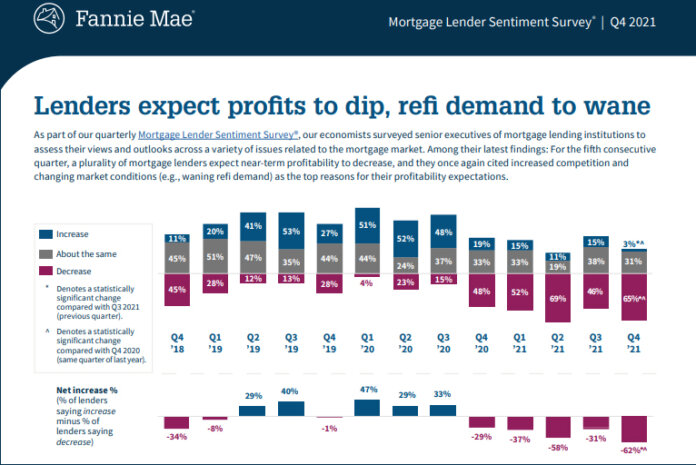For the fifth consecutive quarter, a plurality of mortgage lenders expect near-term profitability to decrease, according to Fannie Mae‘s Q4 2021 Mortgage Lender Sentiment Survey (MLSS).
According to the survey, 65% of mortgage lenders believe profit margins will decrease in the next three months, up from 46% in the prior quarter, while 31% believe profits will remain the same and 3% believe profits will increase. Competition from other lenders and market trend changes were once again the top reasons cited for the profitability expectations.
Additionally, across all loan types, more lenders this quarter reported reduced consumer demand over the previous three months for both purchase and refinance mortgages.
Looking ahead, again across all loan types, lenders on net expect purchase mortgage demand to remain largely stable, while refinance demand is expected to decrease substantially.
“This quarter’s MLSS results suggest that the housing market may be poised to return to a more ‘normal’ state in the new year, following the boom experienced over the past two years due to historically low mortgage rates and pandemic-related changes in homebuyer behavior,” observes Doug Duncan, Fannie Mae’s senior vice president and chief economist. “Mortgage lenders’ profitability outlook has significantly weakened over the past several quarters from its early pandemic run-up.”
“However, net loan production income levels, as reported by the Mortgage Bankers Association, and the width of the current primary-secondary spread – an indicator of potential profitability – allow us to level-set,” continues Duncan. “With both still slightly above pre-pandemic levels, we expect lenders to continue investing in capacity efficiency and process streamlining to maintain profitability despite the thinner-margin environment.”
The primary-secondary mortgage spread, which is correlated with loan production income, averaged 127 basis points in Q3 2021, 13 basis points above the 2019 average, though down from the peak of 174 basis points seen in Q3 2020. Net loan production income has moved similarly, now sitting well below the peak seen in Q3 2020, though it did rise in Q3 2021 and remains well above the 2019 average.
Consumer demand is expected to remain stable for purchase mortgages but decline significantly for refinances. For purchase mortgages, although the net share of lenders reporting demand growth over the prior three months and the next three months, reached the lowest readings for any fourth quarter over the past two years, the direction on net stayed positive for the past three months, with more lenders reporting that demand went up. It stayed neutral for the next three months with lenders equally split between upward and downward demand expectations.
For refinance mortgages, the net share of lenders reporting refinance demand growth over the prior three months, as well as the net share expecting demand growth for the next three months, decreased significantly from last quarter and last year across all loan types, reaching the lowest readings in three years (since Q4 2018).
Lenders expect credit standards to remain largely unchanged. The net share of lenders reporting easing credit standards over the prior three months, as well as the net share expecting easing over the next three months, remained generally flat across the past four quarters.
Economic pessimism among consumers did hit a 10-year high but sentiment toward housing remains flat. In coordination with PSB, Fannie Mae also surveys consumers monthly as part of its National Housing Survey, of which the Home Purchase Sentiment Index is derived. In November, while the overall index remained flat, consumers differ widely on their views of homebuying and home-selling conditions. Only 29% of consumers reported that it was “a good time to buy” a home, while 74% believe it’s a “good time to sell.” Pessimism toward the overall economy also reached a 10-year high, with 70% of consumers reporting that the economy is on the “wrong track”.
Read the Q4 2021 MLSS summary research report here.














